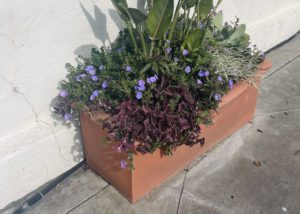Los Angeles Green Building, such as drought landscaping ideas have become a growing topic so as to adapt to California’s harsh heat! “California is growing hotter and drier over the years,” according to the Health Hazard Assessment released by the CALEPA office. In November 2022, California’s Indicators of Climate Change Report demonstrated how climate change has affected the environment and people’s health. California has normalized to the long drought that’s been experienced. Droughts are caused by a region lacking rain, affecting water access, distribution, and crop damage.
We are going over LA drought landscaping ideas to help relieve this issue. First, let’s understand a couple of terms. Horticulture is the science of maximizing plants, whether it’s for landscape, gardening, or agriculture. This knowledge helps to create sustainable, healthier, tolerant plants. As the world’s environment and population change, seeing how horticulture practices apply to our daily lives is essential. The areas of landscape horticulture and olericulture, specifically, can be applied to preparing one’s yard for the summer heat in California.
Green Building – Landscape Horticulture
Landscape horticulture is the organization of a visually pleasing space where the lands focus is on growth and efficiency. Including how the space is mapped out to influence plants to grow harmoniously while looking visually pleasant. Some of the Los Angeles green building examples that come to mind are managing areas of grass or gardening, such as a nursery. To personalize the desire for one’s yard to be organized in a way that complies with the environment is environmental horticulture, which focuses on the restoration of native plants as well as incorporating biodiversity.
With spring already here, let’s look at how to prepare a residential yard for a summer landscape that is drought tolerant. Use spring to adjust for summer by mulching. This will keep the soil moisturized so plants are more likely to thrive. Make sure to water in the early morning or evening. To withstand higher temperatures, plants can be trained to get water less often, but when they do, water long enough so that it reaches deeper into the soil. If there are sprinklers or a drip system, check that they are correctly adjusted to prevent mist or leaks. Make sure to prune, rake and weed out continuously. Check out community assistance environmental programs of Los Angeles.
 Los Angeles Drought Plants
Los Angeles Drought Plants
Beautiful and tolerant plants to last the summer are bountiful in local nurseries. LA drought landscaping ideas include fascinating plants. Some species that do well with heat and long sun exposure are the Tradescantia pallida and Euphorbia tirucalli. These plants thrive in the sun and are colorful. The Tradescantia pallida are frankly hard to kill. It only needs water once a month and does not get diseases. It does well as ground cover, container arrangement orto grow like ivy since it spreads easily. The cool feature is that the leaves are narrow and pointy, and its flowers are adorable tiny pink clusters that are smaller than an inch. If a violet and elegant structure is desirable, this plant would be a great choice for a summer yard.
The Euphorbia tirucalli, looks like it came out from a coral reef and planted on land. Its vibrant orange and reddish hues really bring a yard that coastal vibe. This plant is a succulent shrub, and like the Tradescantia thrives in sun and is also hard to kill. As a shrub, it can grow up to 8 feet tall, prune as preferred. This plant sadly is not pet friendly, do not let it get eaten. It grows well in containers, garden edges, or plant beds.
Some species that are native to Southern California are the Salvia clevelandii and California tree poppy. The Salvia clevelandii is an aromatic shrub that attracts butterflies, bees, and birds such as hummingbirds. This plant features lavender flowers, a fast-growing capability, drought resistance, and impressively blooms year-long. It does well in yards placed in plant beds, garden borders, and slopes. Consider asking a nearby nursery for these plants to bring home. Check out water conservation tips for Los Angeles here.
Green Building – Olericulture
Plant Buddies
A good idea is to plant a fall vegetable such as carrots or oregano near tomatoes. Tomatoes will start to die after the temperature reaches 100 degrees, so that is important to monitor. A refreshing and hydrating choice for a summer vegetable is to grow cucumbers. Cucumbers grow best on a trellis but will also grow in a plant bed. They thrive in a hot climate and can plant near chamomile or beans. Chamomile is useful for making homemade tea, and beans are good neighbors because they adjust nitrogen.

